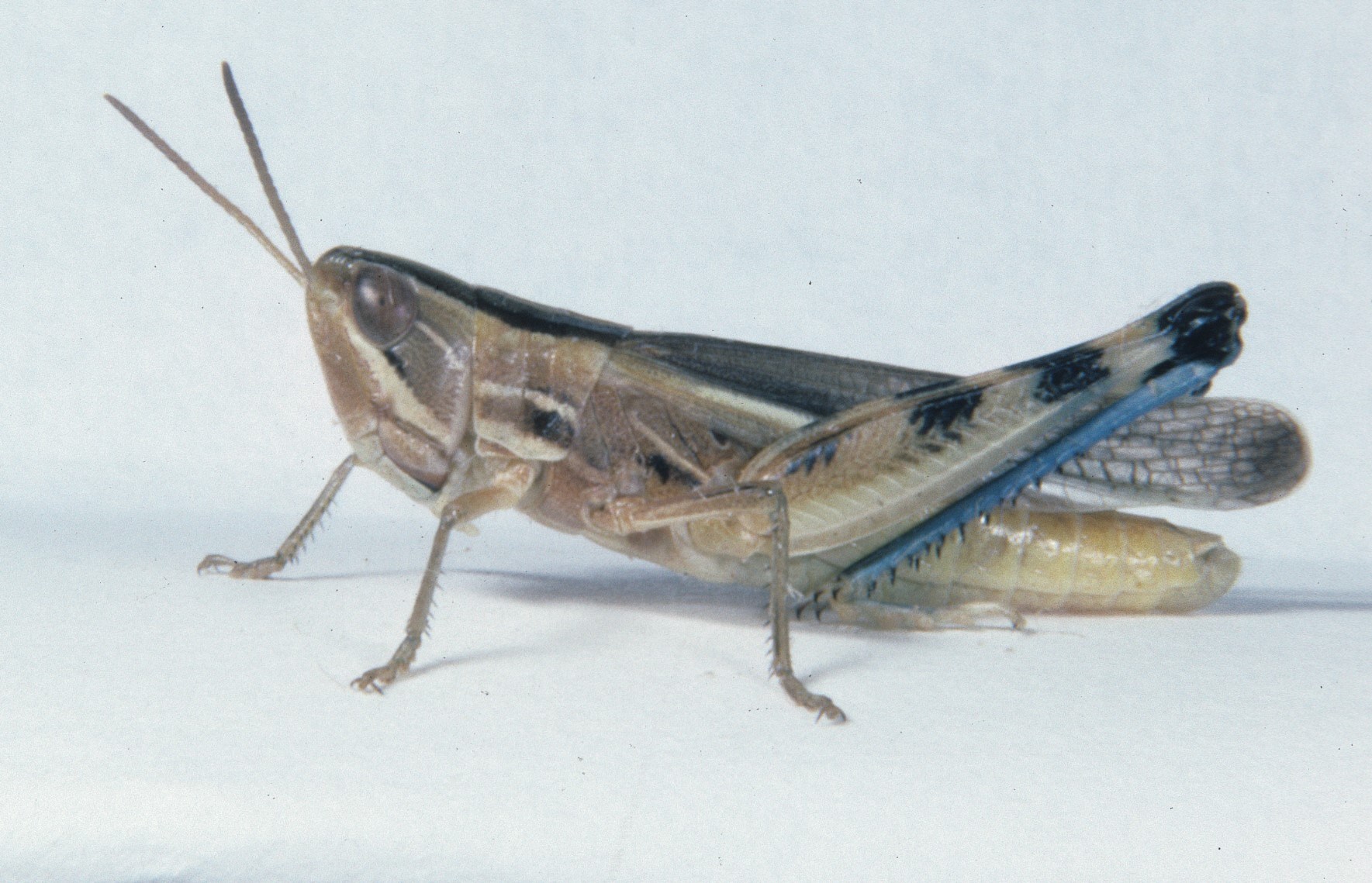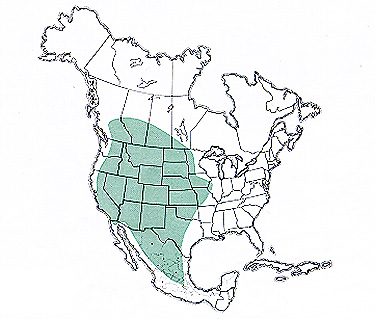Grasshoppers of Wyoming and the West
Entomology
Striped Grasshopper
Amphitornus coloradus (Thomas)
 |
Distribution and Habitat
 A. coloradus continental distribution map >
A. coloradus continental distribution map > The striped grasshopper, Amphitornus coloradus (Thomas), is widely distributed in the grasslands of western North America. The greatest numbers occur in the mixedgrass and bunchgrass prairies.
Economic Importance
The striped grasshopper is a pest of grasses and sedges. It climbs the host plant and with head up chews on the green leaves. It cuts leaves and then holds them by the front tarsi. The cut portion is usually consumed but sometimes falls to the ground and is eaten by another grasshopper or less often becomes litter.
The striped grasshopper is a common member of grasshopper assemblages infesting rangeland. It is often the third most abundant species, but rarely the dominant one. Densities of young adults range from less than one to eight per square yard.
Cage plot tests on native grassland of interior British Columbia demonstrated that the feeding of this grasshopper during its nymphal stage reduced the yield of needleandthread grass by 3.5 pounds per acre for each grasshopper per square yard. An infestation of one young adult per square yard reduced yield 1 pound per day over 1 acre. Live weights of males average 144 mg and of females, 275 mg (dry weight: males 41 mg, females 80 mg).
Food Habits
The diet of the striped grasshopper consists almost exclusively of grasses and sedges. Crop analyses indicate that it feeds chiefly on blue grama, needleandthread, threadleaf sedge, and needleleaf sedge. Seventeen other species of grasses have been detected in crop contents including important rangeland forage grasses (viz., western wheatgrass, prairie junegrass, sandberg bluegrass, and sand dropseed). This grasshopper climbs or rests on the vegetation to feed; it rarely feeds on the ground. Forbs, arthropod parts, and fungi have occasionally been detected in crop contents. Field tests indicate that only 4 percent of a population will feed on bran bait.
Migratory Habits
The striped grasshopper has long wings that extend beyond the end of the abdomen giving it strong powers of flight. Evasive flights are silent, fast, low (2 to 6 inches), short (2 to 7 feet), and straight with a zigzag landing. Although no observations of its dispersal and migration have been made, adults have been collected in Colorado at high mountain altitudes as "accidentals" (adults in locations where the species does not complete its life cycle). Sites of resident populations are prevalent in Colorado up to 5,400 feet and are possibly the breeding habitats for accidentals that have been collected above timberline, as high as 11,400 feet. In Montana a female was taken from Grasshopper Glacier in the Crazy Mountains at 9,680 feet.
Identification
Adults of the striped grasshopper are medium-sized, cream-colored, and profusely striped (Fig. 6 and 7). The top of the head is marked by two diagnostic chocolate brown stripes running above the compound eyes (Fig. 8); these stripes continue onto the pronotum. The antennae are filiform and flat. The head is without lateral foveolae. The pronotum has a low median carina cut once near the middle and an accessory carina on each side of the median carina. The hind femur has three dark brown transverse bands and a dark brown knee. Hind tibiae are pale blue.
The nymphs (Fig. 1-5) are identifiable by their color patterns, structures, and shape:
1. Head with chocolate brown stripe above each compound eye (Fig. 9), stripes continue onto thorax and abdomen; face distinctly slanted; antennae slightly ensiform (Fig. 9); head without lateral foveolae.
2. Pronotum with low distinct median carina, entire in first and second instars, cut once near middle in older instars; two accessory carinae present but faint in early instars.
3. Hind femur of first and second instars with medial area pale tan or cream, older instars with upper medial area and knee suffused with brown.
Hatching
The striped grasshopper is an early-hatching species. First instars appear in the habitat about the same time as those of the bigheaded grasshopper. Embryonic development begins in the summer of deposition. Limited observations indicate that the embryos achieve stage 19 and then diapause, as in the eggs of the bigheaded grasshopper. With rising soil temperatures in spring, the embryos complete development and eventually hatch. The period of hatching lasts for four to five weeks.
Nymphal Development
Nymphs in the mixedgrass prairie of Wyoming develop more slowly than those of the bigheaded grasshopper. They become adults in 50 to 56 days, whereas bigheaded grasshopper nymphs become adults in 36 to 42 days. This difference may be due to the different temperatures to which they are exposed. During most of the day, nymphs of the bigheaded grasshopper remain on the soil surface while nymphs of the striped grasshopper roost above ground on grass plants. In Montana the two species appear to develop at the same time and rate. The nymphal stage normally consists of five instars.
Adults and Reproduction
Adults of the striped grasshopper live in the same habitat in which the eggs hatch and the nymphs develop. Their host plants normally stay green through summer and they tolerate the many enemies inflicting mortalities that average 6 percent each day.
Courtship has been observed infrequently. In a study of daily activity, the adults spent 0.3 percent of their time in courtship in the morning and 0.5 percent in the afternoon. The male stridulates briefly before he makes a copulatory leap onto the female.
A gravid female selects a needleandthread or a threadleaf sedge plant in which to oviposit. She climbs into the center of a plant and, vertically oriented, extends her ovipositor down toward the crown. She holds onto leaves with her fore and midlegs but her hind tibiae are flexed tightly against the femora. In about 30 minutes she deposits four eggs and forms a pod on a stem below the soil surface. During this time she may be attended by a male. After laying her clutch, she climbs up a short distance and works her ovipositor around the exit hole, then crawls away from the plant. Because the outer wall of the pod is constructed of dry fragments of grass sheaths as well as soil particles, the pod is easily overlooked in sampling for grasshopper eggs.
There have been no studies of the fecundity of this grasshopper. The species has one generation annually.
The tough, thimble-shaped egg pod of the striped grasshopper is 7 to 8 mm long and 3 to 4 mm in diameter (Fig. 10). The cap is recessed 1 mm. Eggs are 4.5 to 5.4 mm long, pale yellow, and embedded in dried brown froth. The eggs are vertically oriented at the bottom of the pod.
Population Ecology
In natural habitats populations of the striped grasshopper may remain at low densities ranging from 0.1 to 0.8 per square yard for up to nine years. Populations may also grow gradually, as in Parker's model, doubling for three or four years and then tripling or quadrupling in an outbreak year. This population growth generally parallels the growth of other economically damaging species of rangeland grasshoppers (e.g., the bigheaded, whitewhiskered, and spottedwinged grasshoppers). One of the latter is usually dominant but all contribute to a damaging infestation. Apparently the same favorable factors are operating on many species of rangeland grasshoppers. However, crashes of the populations of each species may come in different years indicating variable responses of species to inimical factors (e.g., temperature and precipitation extremes and specific diseases and parasites). Another difference among these species is the fact that the striped grasshopper rarely becomes the dominant species. When it does dominate, densities do not generally exceed eight young adults per square yard. Records of peak densities of the other species are 20 to 40 young adults per square yard.
Daily Activity
The striped grasshopper spends part of its day on vegetation and part on the ground. At night the nymphs roost head-up on grasses in the habitat. One to two hours after sunrise, they move to the ground and bask by orienting either their sides or their backs perpendicular to the rays of the sun. The adults usually rest on the ground at night under a canopy of grasses. An hour after sunrise they begin basking by exposing their side or back to rays of the sun and hugging the ground. After basking one to two hours, they begin their normal activities of pottering, feeding, and mating.
When temperatures in midsummer rise above 90°F, striped grasshoppers, all adult at this time, climb small shrubs and rest head-up 2 to 8 inches off the ground in the shade. When temperatures decline they return to normal activities. During lower temperatures later in the day, they bask on the ground for about one hour and then move short distances to shelter, resting through the night.
Selected References
Anderson, N.L. 1973. The vegetation of rangeland sites associated with some grasshopper studies in Montana. Montana Agr. Exp. Stn. Bull. 668.
Joern, A., R. Mitschler, H. O'Leary. 1986. Activity and time budgets of three grasshopper species (Orthoptera: Acrididae) from a sandhills grassland. J. Kansas Entomol. Soc. 59: 1-6.
Kemp, W.P. and J.A. Onsager. 1986. Rangeland grasshoppers (Orthoptera: Acrididae): modeling phenology of natural populations of six species. Environ. Entomol. 15: 924-930.
Lockwood, J.A., J.C. Burne, L.D. Debrey, R.A. Nunamaker and R.E. Pfadt. 1990. The preserved fauna of grasshopper glacier (Crazy Mountains, Montana): Unique insights to Acridid biology. Boletin de Sanidad Vegetal (Fuera de serie) 20: 223-236.
Onsager, J.A. and G.B. Hewitt. 1982. Rangeland grasshoppers: average longevity and daily rate of mortality among six species in nature. Environ. Entomol. 11: 127-133.
Pfadt, R.E. 1977. Some aspects of the ecology of grasshopper populations inhabiting the shortgrass plains. Minnesota Agr. Exp. Stn. Tech. Bull. 310: 73-79.
Putnam, L.G. 1962. The damage potential of some grasshoppers (Orthoptera: Acrididae) of the native grasslands of British Columbia. Can. J. Plant Sci. 42: 596-601.
Next Species in Subfamily: Aulocara elliotti

